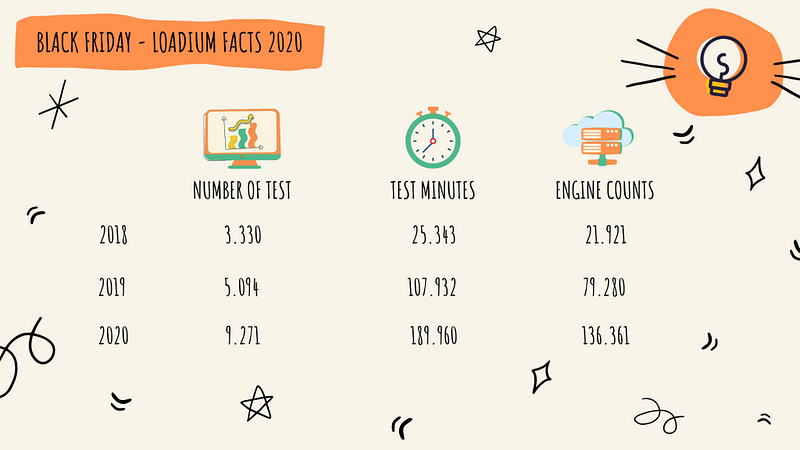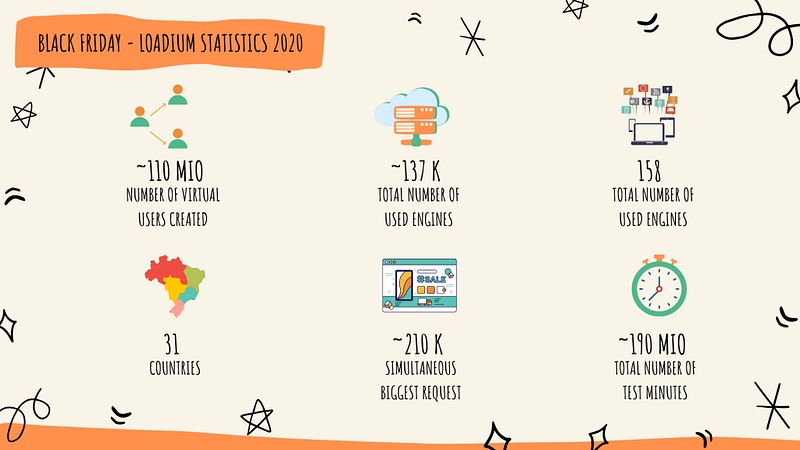Jmeter vs Loadrunner Which Load Testing Tool Should You Choose
Load Testing | Best Practices For Black Friday
Load Testing | Best Practices For Black Friday

As Loadium, we have gathered the load testing best practices for you under this article. Black Friday is considered to be the busiest shopping day of the year and each year, online retail sales reach their peak. But it is always like a nightmare for retailers and makes them fret about reaching expected revenue.
Next Black Friday is a couple of months from now, and this is the perfect time to analyze what happened last year, learn from mistakes, and get your website ready for the peak season crowds.
What Is Load Testing?
Load testing is a kind of non-functional software testing that measures response times, throughput rates, and resource-utilization levels, and it identifies your application’s breaking point with the simulated load as near as possible to the released product.
Load testing provides answers to questions that are asked by dev and product teams like “Does the product run under these conditions?” or “Is the performance of the product enough for my audience?”. So the main purpose of load testing is to ensure stability and improve performance bottlenecks.
What Are The Changes In Black Friday 2019 And 2020
The closure of physical stores during the pandemic has caused a lot of confusion around what the Black Friday weekend — the biggest sales weekend in e-commerce — would actually look like this year.
So far, we saw that:
- Many physical stores are closed this weekend due to continued restrictions
- Stores that are open are seeing less traffic than usual.
- Online competition is greater than it has ever been before.
Because of high volume traffic expectations, most e-commerce focused on their performance. Also, the increase in test traffic on Loadium by 78% on average compared to 2019 was an indication that something will change in 2020 Flack Friday.
Here are the 2020 Black Friday Loadium load test statistics in numbers:


Why Do Companies Need Load Testing?
Successful load testing lends the assurance of a high-quality application that can serve a large number of users of the organization. Load testing ensures that the software performs to render high user satisfaction by testing, finding bottlenecks, and tweaking.
Load Testing Best Practices
Next Black Friday is one year from now. Maybe this seems a very long time from now, but it’s never too early to start preparing for peak season traffic and making sure your website has good performance enough.
In fact, some e-commerces start their Black Friday performance testing as early as January! But no matter when you start, just make sure you have enough time for fixing bottlenecks, errors, and bugs due to high traffic spikes.
Analyzing The Environment
The test environment will also have a large impact on your load tests. It must be picked wisely because it will not always be possible to test in every environment. This stage also helps identify the possible challenges a tester may face while load testing. To better analyze the test environment, you need to:
- Define requirements, and analyze test goals that you need.
- Decide the testing scope along with the test initiation checklist.
- Identify the logical and physical production architecture for load testing, and identify the software, hardware, and networks configurations required for kicking off the load testing.
- Compare both test and production environments while identifying the testing environment.
- Get resolve the environment-related concerns if any, and analyze whether additional tools are required for load testing.
Identifying The Performance Acceptance Criteria
Load testing acceptance criteria refer to data that is collected through the process of load testing and that is anticipated to have value in determining or improving the quality. Identify the desired performance characteristics of the application like Response time, Throughput, and Resource utilization.
Planning & Designing Load Tests
Planning and designing load tests involve identifying crucial scenarios, determining suitable variability across users, identifying and generating test data, and specifying the metrics to be collected.
Ultimately, the items will provide the base for workloads and workload profiles. The output of this stage contains the necessary conditions for test execution (all required resources, tools, and test data are ready).
Configuring The Test Environment
The throughput of this stage is configured load-generation environment and resource-monitoring tools. Prepare your conceptive strategy, available tools, and designed tests along with the testing environment before execution.
Implementing The Test Design
According to test planning and design create your load tests. With Loadium, you can create your load test with a few clicks and after running you can see the amazing reports and graphs.
Executing Load Tests
- Gather and analyze the data.
- Problem Investigation like bottlenecks (memory, disk, processor, process, cache, network, etc.) resource usage like (memory, CPU, network, etc.,)
- Generate the performance analysis reports containing all performance attributes of the application.
- Based on the analysis prepare a recommendation report for the dev team.
- Repeat the above test for the new build received from the client after fixing the bugs and implementing the recommendations
- Run the load test again for the new build after fixing the bugs and implementing the recommendations
Analyze Results, Report & Retest
Consolidate, examine and share test results with stakeholders.
Then fine-tune and test again to see if there is an improvement or decrease in performance. If any specific test result is within the specified metric limit & all results are between the thresholds limits then testing of the same scenario on a particular configuration is completed.
Common Performance Problems
In software testing, speed is one of the crucial features. Users are never happy to work with a slow system. The load testing uncovers the performance bottlenecks & defects to maintain the interest and attention of users. Here are the most common performance problems observed:
- Poor response time
- Long load time
- Bottlenecking
- Poor scalability
- Software configuration issues (for the Web server, load balancers, databases, etc.)
- Disk usage
- Operating system limitations
- Poor network configuration
- Memory utilization
- CPU utilization
- Insufficient hardware resources
Conclusion
For any software to run properly, load testing plays a key role. It guarantees customer satisfaction and eliminates the risk of product failure. So it is vital to carry out a load test before Black Friday.
Enjoyed this article? Check out Loadium for more!
 10 free test runs with up to 100 concurrent users
10 free test runs with up to 100 concurrent users